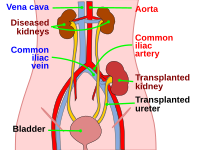
P064 Kidney allocation strategy for highly sensitized patients based on epitope virtual crossmatch: Pernambuco experience
Sign Up to like & getrecommendations! Published in 2017 at "Human Immunology"
DOI: 10.1016/j.humimm.2017.06.124
Abstract: Aim Brazil has a public transplant program. Potential recipients are ranking by HLA match, age, time in waiting list and PRA > 50%. However, transplantability among highly sensitized patients is 10 times lower than among non-highly sensitized.… read more here.
Keywords: sensitized patients; allocation strategy; kidney allocation; highly sensitized ... See more keywords

P150 Utilization of two different Luminex single antigen beads assays (SAB) platforms in patients with unusual reactivity patterns
Sign Up to like & getrecommendations! Published in 2017 at "Human Immunology"
DOI: 10.1016/j.humimm.2017.06.210
Abstract: Luminex Single Antigen Beads Assay (SAB) are currently the most widely used means to identify HLA antibodies in sera from sensitized transplant candidates. Although these assays greatly enhance solid organ transplantation practices in terms of… read more here.
Keywords: antigen beads; unusual reactivity; reactivity; luminex single ... See more keywords

Analysis of Kidney Transplantation Results of Very Highly Sensitized Patients Included in a Virtual Crossmatch Programme and their Kidney Pairs. Results of 5 Years Since the Beginning of the Protocol. Andalusian Group for Highly Sensitized Patients
Sign Up to like & getrecommendations! Published in 2018 at "Transplantation"
DOI: 10.1097/01.tp.0000543445.27772.2c
Abstract: Andalusian Group for Highly Sensitized Patients. Background Organ-exchange strategies based on virtual crossmatch (V-XM) can improve kidney transplantation in very highly-sensitized (HS) patients. Methods Andalusia started a V-XM protocol for very-HS patients in june, 2012… read more here.
Keywords: group; kidney transplantation; highly sensitized; sensitized patients ... See more keywords

Does the Canadian allocation system for highly sensitized patients work?
Sign Up to like & getrecommendations! Published in 2019 at "Current Opinion in Organ Transplantation"
DOI: 10.1097/mot.0000000000000635
Abstract: PURPOSE OF REVIEW The number of sensitized heart transplant candidates is rising. Highly sensitized patients are disadvantaged because they encounter longer waiting times to heart transplant. Strategies to reduce their waiting times include waitlist prioritization… read more here.
Keywords: transplant; highly sensitized; sensitized patients; allocation system ... See more keywords

The Introduction of cPRA and Its Impact on Access to Deceased Donor Kidney Transplantation for Highly Sensitized Patients in Australia.
Sign Up to like & getrecommendations! Published in 2020 at "Transplantation"
DOI: 10.1097/tp.0000000000003410
Abstract: BACKGROUND In March 2016, Australia's deceased donor kidney allocation program introduced calculated panel reactive antibody (cPRA) based on antibody exclusions using multiplex assays to define sensitization for waitlisted candidates. We aimed to assess the impact… read more here.
Keywords: introduction cpra; highly sensitized; sensitized patients; deceased donor ... See more keywords

Allocation to highly sensitized patients based on acceptable mismatches results in low rejection rates comparable to nonsensitized patients
Sign Up to like & getrecommendations! Published in 2019 at "American Journal of Transplantation"
DOI: 10.1111/ajt.15486
Abstract: Whereas regular allocation avoids unacceptable mismatches on the donor organ, allocation to highly sensitized patients within the Eurotransplant Acceptable Mismatch (AM) program is based on the patient's HLA phenotype plus acceptable antigens. These are HLA… read more here.
Keywords: rejection; highly sensitized; regular allocation; sensitized patients ... See more keywords